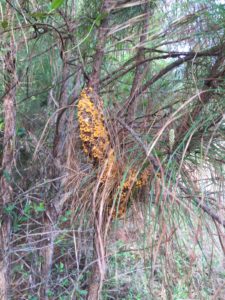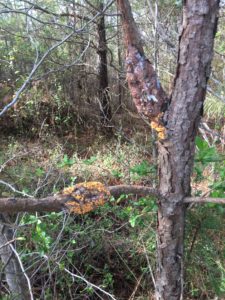So, What Is the Orange Stuff on My Pine Trees?
go.ncsu.edu/readext?457957
en Español / em Português
El inglés es el idioma de control de esta página. En la medida en que haya algún conflicto entre la traducción al inglés y la traducción, el inglés prevalece.
Al hacer clic en el enlace de traducción se activa un servicio de traducción gratuito para convertir la página al español. Al igual que con cualquier traducción por Internet, la conversión no es sensible al contexto y puede que no traduzca el texto en su significado original. NC State Extension no garantiza la exactitud del texto traducido. Por favor, tenga en cuenta que algunas aplicaciones y/o servicios pueden no funcionar como se espera cuando se traducen.
Português
Inglês é o idioma de controle desta página. Na medida que haja algum conflito entre o texto original em Inglês e a tradução, o Inglês prevalece.
Ao clicar no link de tradução, um serviço gratuito de tradução será ativado para converter a página para o Português. Como em qualquer tradução pela internet, a conversão não é sensivel ao contexto e pode não ocorrer a tradução para o significado orginal. O serviço de Extensão da Carolina do Norte (NC State Extension) não garante a exatidão do texto traduzido. Por favor, observe que algumas funções ou serviços podem não funcionar como esperado após a tradução.
English
English is the controlling language of this page. To the extent there is any conflict between the English text and the translation, English controls.
Clicking on the translation link activates a free translation service to convert the page to Spanish. As with any Internet translation, the conversion is not context-sensitive and may not translate the text to its original meaning. NC State Extension does not guarantee the accuracy of the translated text. Please note that some applications and/or services may not function as expected when translated.
Collapse ▲Spring has sprung in most of North Carolina, bringing about many changes in the woods. The dogwoods are blooming and so is fusiform rust (or sporulating). You may be wondering exactly what is fusiform rust? Fusiform rust is caused by the fungus Cronartium quorum f. sp. fusiforme, and produces bright orange spores in the spring on southern yellow pines, especially loblolly pine.

Orange spores of fusiform rust on loblolly pine
These spores are produced on pines usually from late-March through mid-April. Like many rust diseases, fusiform rust requires two hosts to complete it’s lifecycle and oaks, such as willow, water, and laurel, are the secondary host. The disease is much less conspicuous on oaks, and normally does no harm to them. The disease produces a different kind of orange spore on underside of the oak leaf from late-April to mid-June. These spores are blown back to the pines where the disease causes galls and cankers that can weaken the tree, reduce it’s value for timber, increase wind susceptibility, and cause death.
Loblolly and slash pine are the most susceptible pines to the disease. Longleaf is moderately resistant and shortleaf is highly resistant. Because the disease weakens the trees, secondary pests can become an issue. The weakened condition of the tree can cause secondary infections by the pitch canker fungus (Fusarium moniliforme var. subglutinans), black turpentine beetles (Dendrodoconus frontalis) and coneworms (Dioryctria spp.) causing further damage to the trees reducing value and possibly death.
Control methods for fusiform rust include spraying fungicides in a nursery setting. Plant shortleaf or longleaf pine in areas with a history of high disease incidence, and in areas with low or moderate disease incidence, increasing tree populations at planting have been recommended. Pruning branch cankers and removing diseased branches can help lower stem infection potential. Once the stem is infected, branch pruning is not recommended. Diseased trees are not a direct risk to the surrounding healthy ones, since spores that infect pines come only from oak leaves. Loblolly and slash pine improved seedlings from state and private nurseries offer better rust resistance and improved growth and should be used in place of natural regeneration methods.

Branch canker with spores
Finally, stands that are impacted by rust with stem cankers can be salvaged during a thinning operation for pulpwood unless the stand is left with too low of a stocking rate. The following rule of thumb may be useful in planning the salvage of trees with trunk cankers: (a) Less than 50 percent of circumference killed-more than an even chance of salvage for 8 years; (b) 50 percent of circumference killed but no bend in stem at canker or sunken canker face-an even chance of salvage for 5 years; (c) 50 percent of circumference killed, with a bend at canker and either a normal or sunken canker faceless than even chance of salvage for 5 years.


